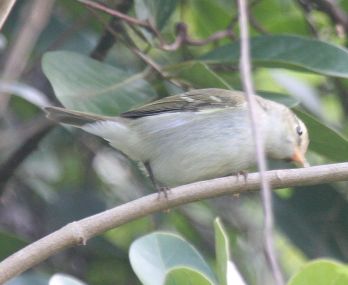A good week this week, with lots of birds around - one of my best ever weeks for species count. It's a few degrees cooler this week than last.
Autumn is the best time to see visible migration on Po Toi, the best location is the South Peninsular lighthouse in the first two hours after dawn.
Late October is the time for pipits to come in, this week four species, mostly Richard's and Olive-backed with a few Red-throated and three Pechora. Also this Pacific Swift.

This year an added bonus to the species list has been the newly formed grasslands on the South Peninsular following the Ching Ming fire which destroyed most of the heavy vegetation and allowed the grass to flourish. This week, as well as the usual Zitting and Bright-capped Cisticolas and Plain Prinias, I had Pallas's Grasshopper Warbler, Lanceolated Warbler, Black-browed Reed Warbler (very rare on Po Toi, perhaps only the second ever record) and another warbler with the shape, size and colour of a Blunt-winged Warbler.
Unfortunately, it's almost impossible to photograph these birds unless you have a camera mounted on your head, something I have thought about trying. They just scuttle from one patch of grassland to another. The worst scuttlers are the Lanceolated Warblers, they are more like mice than birds.
Leaf Warblers are another ID problem at this time of year, when they seem reluctant to call. Here two photos of a Two-barred Greenish Warbler, which did call, and I think a 'Two-barred' Arctic Warbler, which didn't call. The Greenish (a pair) sounded like a Great Tit to me, which is why I was attracted to them - Great Tits are rarer on Po Toi than Greenish Warblers.



Note the black legs of the Greenish, the clean white underparts and the different shaped supercilium compared to the Arctic.
Also arriving this week were buntings, here a Little, Yellow-browed and Chestnut Bunting (just)



Sometimes it's as interesting what you don't see as what you do. In October on Po Toi, I don't see Barn Swallow or Japanese White-eye.
The autumn migration of Barn Swallows finishes by the end of September and from there on, except for a few in November, I don't see any more until spring migration starts in February.
A few Japanese White-eye summer on Po Toi but these leave in September and the wintering birds don't arrive until November - which lends support to the suggestion in Avifauna that the summer and winter populations of Japanese White-eye in Hong Kong are different.
My report this week is almost as long as my bird list.
[
Last edited by wgeoff at 18/08/2010 12:13 ]


